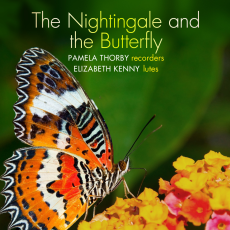The Nightingale and the Butterfly - Pamela Thorby & Elizabeth Kenny - Audio Video Club of Atlanta
I almost passed on the chance to review this new offering by recordist Pamela Thorby and lutenist Elizabeth Kenny. I'm glad now that I didn't. "The Nightingale and the Butterfly" is a choice selection of music from French Baroque composers Louis Caix d'Hervelos, Robert de Visée, Anne-Danican Philidor, Charles Dieupart, and François Couperin. All were older contemporaries of Bach and Handel, and influenced the developing styles of those two luminaries through the development of the French "Ouverture" as a musical form. The music heard here is notable for more than just its sensual beauty and economy. These composers wrote music with a deeper purpose, that of providing listener and performer alike with a manner of spiritual recreation and renewal, a means of accessing sources of meditation, contemplation, and healing: qualities that are as valid today as they were then.
Pamela Thorby and Elizabeth Kenny obviously enjoy the music heard on this disc, and they invest a lot of themselves in it. As Kenny puts it, "I've always loved playing French music for its straight-to-the-heart singing melodies that seem to arise naturally from the physical makeup of the instrument or voices for which they are written." We sense this, too in the way Thorby caresses and shapes the gracious recorder melodies, taking them with incredible velocity when the occasion demands, but always with the appropriate amount of feeling for their exquisite beauty.
Here, Thorby plays a variety of instruments, including alto and soprano recorders and a flûte de voix, or "voice flute," a tenor recorder in D that was prized because it could cover the range of the soprano voice. Kenny plays Baroque guitar, archlute, and (my personal favorite) theorbo, a long-necked lute after Italian originals that sounds rich and authoritative in two selections by Robert de Visée, a noble Passacaille and a Suite in D with a Sarabande whose melody sounds like a cousin of the famous Spanish tune "La Follia."
Her theorbo and Thorby's alto recorder make beautiful discourse together in the two fugues that are a remarkable feature of Philidor's zestful Sonate pour flûte à bec in D minor. There are a lot of other beauties to savor here, including d'Hervelois' Suite in G Major, whose sprightly 4th Papillon (Butterfly) movement gives the album part of its title, and the three tastefully decorated pieces in which Couperin was inspired by one of nature's supreme singers, le Rossignol (The Nightingale), which provides the other part. And let's not forget the two Suites by Dieupart in A major and F minor, which are among the finest examples of the French Ouverture style.


